Australian Leather Infantry Equipment - Belts, Braces, and Straps
Waist belt
 The Waist belt for the Infantry Equipment, Australian Pattern (Leather) is a copy of the W.E. Patt. '08 Waist belt reproduced in leather. As with most components of this equipment, there are two main variations, the first with standard Twigg buckles and the second with tongued buckles. There are a few differences worth noting between this Belt and the Pattern 1908 one. Although the Australian Pattern Belt has a double Twigg front buckle, one does not pass the free end of the Belt back through it Patt. '08 style. Instead, the free end of the Belt passes through the buckle in normal trouser belt fashion, and is secured in place by a floating leather keeper. Next, you can see a series of holes in the Belt to either side of the center down tabs. These are for securing the studs on the Cartridge carriers. This first issue example is not maker marked and is undated. From the Graham Tweeddale Collection, photos © Graham Tweeddale 2009.
The Waist belt for the Infantry Equipment, Australian Pattern (Leather) is a copy of the W.E. Patt. '08 Waist belt reproduced in leather. As with most components of this equipment, there are two main variations, the first with standard Twigg buckles and the second with tongued buckles. There are a few differences worth noting between this Belt and the Pattern 1908 one. Although the Australian Pattern Belt has a double Twigg front buckle, one does not pass the free end of the Belt back through it Patt. '08 style. Instead, the free end of the Belt passes through the buckle in normal trouser belt fashion, and is secured in place by a floating leather keeper. Next, you can see a series of holes in the Belt to either side of the center down tabs. These are for securing the studs on the Cartridge carriers. This first issue example is not maker marked and is undated. From the Graham Tweeddale Collection, photos © Graham Tweeddale 2009.
 The inside view of the same first issue Belt.
The inside view of the same first issue Belt.
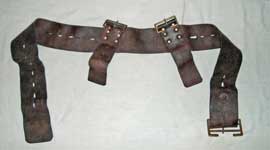
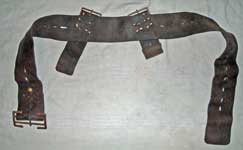 This second issue example is not maker marked and is undated. It is, however, stamped with a large "M", which designates "Medium". The Belt came in three sizes, as did the Patt. '08 Belt. From the Karkee Web Collection.
This second issue example is not maker marked and is undated. It is, however, stamped with a large "M", which designates "Medium". The Belt came in three sizes, as did the Patt. '08 Belt. From the Karkee Web Collection.
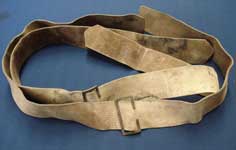 Infantry Equipment, Australian Pattern (Leather) Braces are simple 2-inch wide leather straps. First issue examples, like this pair, used the tongueless Twigg buckles shown here, and therefore didn't have holes punched in them. You can see that one end of each Brace, originally flat, has been reshaped to make it easier to insert into a buckle. These Braces are maker marked "Holden & Frost" and are dated either 1915 or 1916. From the Brian J. Burnes Collection, photos © Brian J. Burnes 2009.
Infantry Equipment, Australian Pattern (Leather) Braces are simple 2-inch wide leather straps. First issue examples, like this pair, used the tongueless Twigg buckles shown here, and therefore didn't have holes punched in them. You can see that one end of each Brace, originally flat, has been reshaped to make it easier to insert into a buckle. These Braces are maker marked "Holden & Frost" and are dated either 1915 or 1916. From the Brian J. Burnes Collection, photos © Brian J. Burnes 2009.

 Details of the same pair of first issue Braces, showing the maker's mark.
Details of the same pair of first issue Braces, showing the maker's mark.
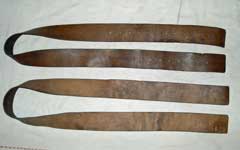 Second issue Infantry Equipment, Australian Pattern (Leather) Braces. Second issue examples like this pair have holes punched in both ends to engage the tongued buckles in the other components of the equipment. The Braces each carry a 2-inch Twigg buckle, tongued in the second issue (not shown in this picture). These particular Braces are maker marked "EW" and "HD" but are not dated. From the Karkee Web Collection.
Second issue Infantry Equipment, Australian Pattern (Leather) Braces. Second issue examples like this pair have holes punched in both ends to engage the tongued buckles in the other components of the equipment. The Braces each carry a 2-inch Twigg buckle, tongued in the second issue (not shown in this picture). These particular Braces are maker marked "EW" and "HD" but are not dated. From the Karkee Web Collection.
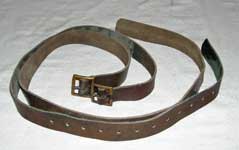
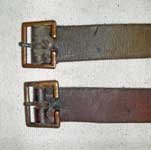 The Supporting straps for the Infantry Equipment, Australian Pattern (Leather) are copies of the W.E. Patt. '08 Supporting straps reproduced in leather. As with most components of this equipment, there are two main variations, the first with standard Twigg buckles and the second with tongued buckles. The detail shows a close-up view of the tongued Twigg buckle unique to Patt. '15. This second issue pair is maker marked "TELFORD BROS" and dated 1916. From the Karkee Web Collection.
The Supporting straps for the Infantry Equipment, Australian Pattern (Leather) are copies of the W.E. Patt. '08 Supporting straps reproduced in leather. As with most components of this equipment, there are two main variations, the first with standard Twigg buckles and the second with tongued buckles. The detail shows a close-up view of the tongued Twigg buckle unique to Patt. '15. This second issue pair is maker marked "TELFORD BROS" and dated 1916. From the Karkee Web Collection.
Belt, waist, Cadet Pattern (N.I.V.)
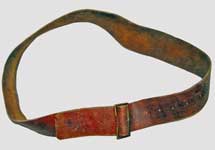
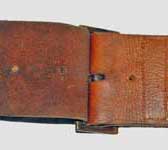 For many years collectors thought the conversions of Infantry Equipment A.P. Braces were unofficial “walking out” belts converted by the soldiers themselves, but recent research has proved otherwise. By 1930 stocks of Belts, waist, brown leather, Cadet, C.P. (Commonwealth Pattern) originally introduced in 1910 with the advent of Universal Military Training, must have been running low and those Cadet Detachments not supported by Militia Units or entitled to Belts, waist, Infantry Equipment, A.P. under Military Board Instruction Q.10 / 1930 were in need of belts. With the general withdrawal of Infantry Equipment A.P. from Militia Units under M.B.I. Q.9 / 1930 at the cessation of Universal Military Training & the subsequent reissue of the Belts, waist to some Cadet Detachments, meant there was a surplus of Braces and someone, probably influenced by unofficial belt conversions of Patt. ’08 Braces during the Great War, decided how to put them to use. The resulting Belt, waist, Cadet Pattern, was introduced on 22nd March 1930 by Local Modification L.M. 74 approving conversion of sufficient Braces, with buckle, Infantry Equipment A.P. to meet requirements. A sample Belt was to be supplied to each Chief Ordnance Officer. (It is believed that there was a C.O.O. for each Military District.)
For many years collectors thought the conversions of Infantry Equipment A.P. Braces were unofficial “walking out” belts converted by the soldiers themselves, but recent research has proved otherwise. By 1930 stocks of Belts, waist, brown leather, Cadet, C.P. (Commonwealth Pattern) originally introduced in 1910 with the advent of Universal Military Training, must have been running low and those Cadet Detachments not supported by Militia Units or entitled to Belts, waist, Infantry Equipment, A.P. under Military Board Instruction Q.10 / 1930 were in need of belts. With the general withdrawal of Infantry Equipment A.P. from Militia Units under M.B.I. Q.9 / 1930 at the cessation of Universal Military Training & the subsequent reissue of the Belts, waist to some Cadet Detachments, meant there was a surplus of Braces and someone, probably influenced by unofficial belt conversions of Patt. ’08 Braces during the Great War, decided how to put them to use. The resulting Belt, waist, Cadet Pattern, was introduced on 22nd March 1930 by Local Modification L.M. 74 approving conversion of sufficient Braces, with buckle, Infantry Equipment A.P. to meet requirements. A sample Belt was to be supplied to each Chief Ordnance Officer. (It is believed that there was a C.O.O. for each Military District.)
Quantities converted & subsequent history are unknown at this stage & by the time the BELTS, waist, cadet pattern were declared obsolete by Australian Changes in War Materiel AC No. 5770 of 31 January 1951, there were no stocks held in Ordnance depots. It appears from AC No. 5770, that the Belts never acquired a V.A.O.S. number.
These Belts have been seen made from both first type Braces with tongueless buckles and from second type Braces with tongued buckles, while others appear to have been made from first type Braces with holes and a tongued buckle added. Some Belts have been noted that have been lacquered brown; presumably this was to match the brown accoutrements intended to be worn with the Belt. (M.B.I. G.51 / 1936 specifies that each cadet in Detachments at Approved Educational Establishments be issue with 1 Belts, waist, cadet pattern and 2 Pockets, cartridge, 15 rounds, Mk II while each detachment was to have 50 Frogs, brown, bayonet.) The presence of unofficial “walking out” belts confusing the issue still cannot be discounted. Research is ongoing & the KWRT is keen to hear from anyone who can add to what is known on these Belts.
The example illustrated, from the Grant Napier Collection, was made from a second issue Brace. It has been shortened, a standard tongued Twigg buckle sewn in and lacquered brown. Photographs © Grant Napier 2008.
This sub-section is currently listed under Infantry Equipment Australian Pattern because of its obvious ancestry, but will eventually be moved to a future section, under development, on Australian Cadet Equipment.